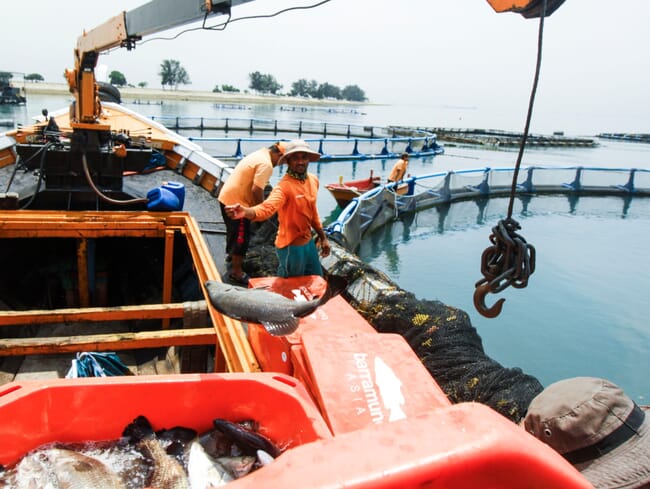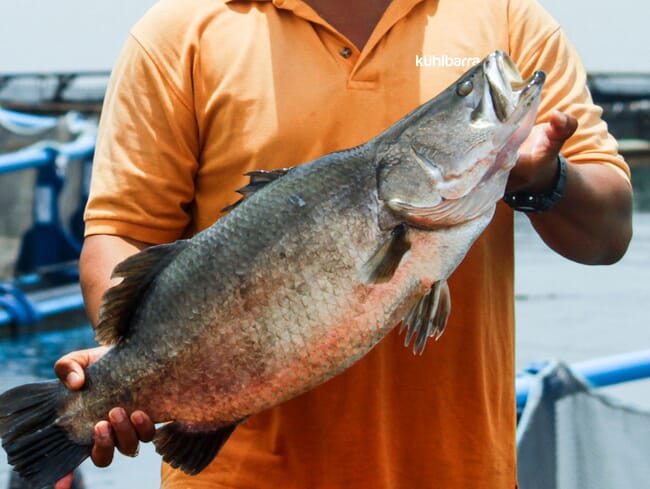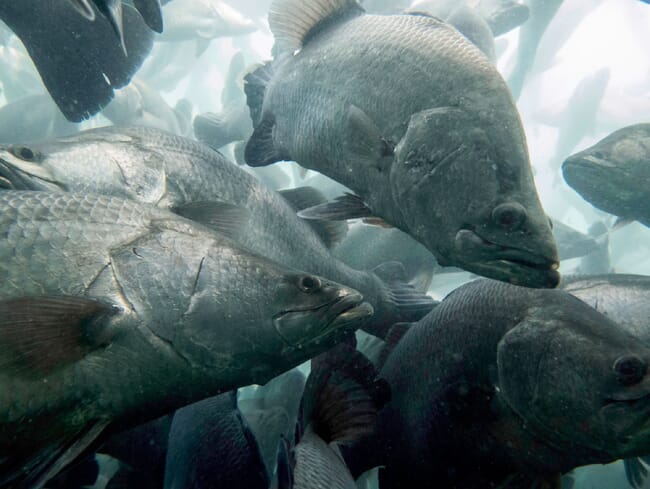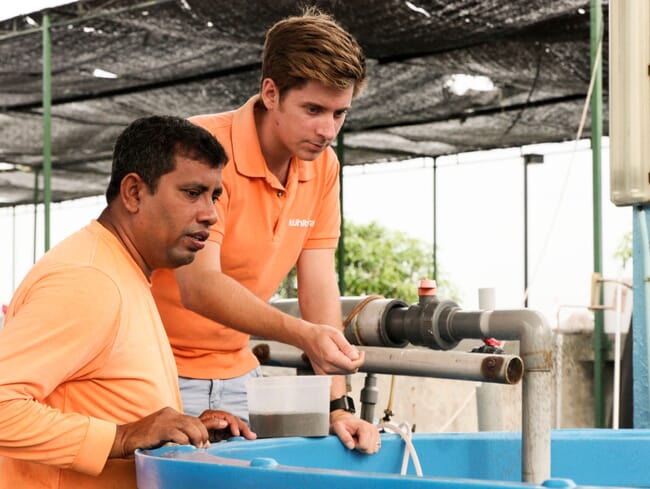In 2008, Dutchmen Joep Staarman (former Skretting Japan and Marine Harvest Asia-Pacific managing director) and Hans den Bieman
(former Nutreco COO and Marine Harvest CEO) had an idea. They reasoned that people eat salmon for its robust and unique flavor – but the strong taste prevents some people from continuously consuming the fish. Barramundi on the other hand has the same firm structure and excellent presentation – but with a milder, smoother taste. Barramundi might then appeal to a potentially-larger customer base, especially for those who want to eat fish several times weekly.

© Barramundi Asia
With their combined knowledge and experience, the duo started Barramundi Asia and began professionalising the culture of Asian sea bass by establishing a hatchery, nursery and grow-out farm in Singapore. Within a few years, production grew to 1,000 tonnes, with licenses to expand to 6,000 tonnes.
The culture protocol developed by the company is similar to salmon. Juvenile fish are grown in tanks to at least 100 grams, after which they are stocked in cages at an average density of 35 kilograms per cubic meter. Depending on the temperature of the farming locality, it takes the fish from 1.5 to 2 years to reach their harvest size of 4 to 5 kilograms. Larger fish tend to have tougher flesh.

The barramundi are then processed in Singapore and sold fresh, whole, gutted, filleted or as individual portions.
Staarman explains however, that Singapore has limited possibilities for expansion and cage culture comes with a host of biosecurity risks. Singapore is a hub for the culture and export of ornamental fish, a variety of diseases have become endemic to the region. Barramundi Asia thus opted to split risks and start a second farm.
As barramundi is the national fish of Australia, where demand is always high, in 2018 they opened another hatchery and grow-out farm in northwest Australia. This second site currently has a production of 1,000 tonnes with an additional capacity of 15,000 tonnes.

© Barramundi Asia
Similar to major players in the salmon industry, Barramundi Asia simultaneously worked on developing and vertically-integrating other business elements to further improve both farm performance and profitability. This included producing a line of vaccines for seven different diseases, a net cleaning business, and with their extensive experience in feed production, the future possibility of developing their own line of feeds.
With limited growth potential in Singapore, and a longer growth period and higher expenses in Australia, plans were forged to expand production around Southeast Asia in 2018. Eyes were set on Brunei, a small country located at the northwestern tip of Borneo. Sitting right on the equator and flushed with warm waters to accelerate barramundi growth, Brunei still has pristine waters surrounding vast and healthy forests. Moreover, it has limited to no aquaculture operations, giving Barramundi Asia a biosecure environment for its operations. Unlike most of Southeast Asia, Brunei is not severely hit by typhoons, another major risk factor for aquaculture farms operating in the region.
Working closely with the national government of Brunei, a 6,600-hectare area 12 kilometers from the coast was earmarked for barramundi aquaculture. In return for job opportunities and other local benefits, the government has set up a rewarding lease agreement for the company.
Still, the new site faces some challenges: being 12 kilometers from shore, currents and waves can be significant. The company will thus run trials with different cage designs to see what model is best suited for local conditions.
After the trial, the first cages are due to be stocked in 2020, with a nursery to be constructed as well. The hatchery in Australia will initially supply the necessary fry, but Staarman explains that the company has long-term plans to develop a local sea bass strain that is specially adapted and optimised for local conditions in Brunei. The farm’s goal is to eventually reach a staggering production of 36,000 tonnes, using an initial investment of about €10 million Euro.
Barramundi Asia is also very conscious and committed to sustainability. Staarman explains: “Asian sea bass are relatively slow-growing fish, taking the company longer to grow its operations, compared for example to shrimp farmers that harvest in 3 to 4 months. As such it is inherent to the business to think long-term and work sustainably.”

© Barramundi Asia
He also explains that the biggest footprint and impact of aquaculture operations is caused by high-protein feeds in combination with outdated feeding protocols. “Our company has chosen to use solely high-quality feeds from Skretting. Their pellet maintains its integrity much longer and thus minimises waste, importantly it also contains a large portion of plant-based ingredients, thereby reducing the environmental impacts of the feed and reducing pressure on wild fish, which are used by most other producers."
Staarman adds that, by selecting an offshore site with a high rate of water exchange, the farm’s environmental impacts will be further minimised. The company also plans to rotate production and use a fallow system.
These accomplishments have already won the company Good Aquaculture Practice (GAP) certification by local authorities, plus BAP 4-star certification for its sites in Singapore and Australia. However, the company’s ultimate goal of becoming ASC-certified has met significant hurdles.
“ASC has strongly aligned itself with European retailers, convincing most of them to source only ASC-certified and cultured seafood,” says Staarman. "And ASC certification standards are mostly species-specific. Despite patiently waiting for the last two years, an Asian sea bass standard has yet to be released.” As the EU is the world’s largest seafood market, this has strained the goals of the company.
However, this need should be met by the publication of the ASC's new marine finfish standard, which covers barramundi and was released last week.
“By releasing the long-awaited and much-needed Asian sea bass standards, our company can finally deliver sustainably-certified Asian sea bass to the European Union,” concludes Staarman.

